
Can Draft Capital Help Predict Tight End Success?
In our 63-part analytical series, “Does It Matter?”, we next wanted to look into the intriguing question of whether a Tight End’s
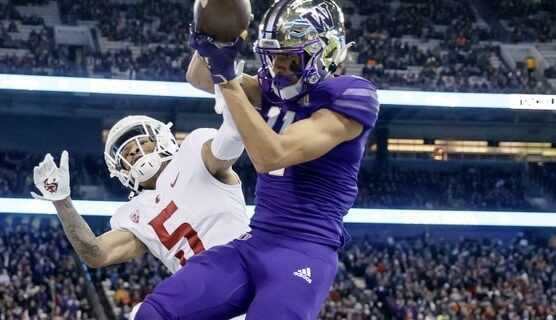
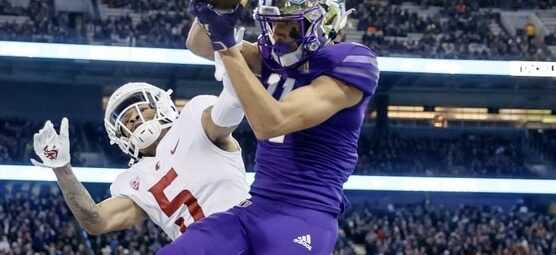
For part 17 of our “Does It Matter?” series, we dove into the data to figure out whether shuttle times at the NFL Combine can predict success for wide receivers in fantasy football. Further, we looked to uncover a range which occurs in top level performances most frequently.
To maintain consistency in our numbers, we strictly used NFL Combine shuttle times. Further, we only looked at WRs who finished in the top 50 in fantasy football points per reception (PPR) since 2003. Throughout this study, you will see the “bottom 10” term which is defined as PPR finishers 41st-50th every season.
We created an averages chart showing the shuttle times for WRs in different finishing categories. The goal of this was to get an initial feel for whether lower shuttle times are for sure going to prevail more top Level performances or not. The chart’s categories are as follows:
However, our findings from this data were inconclusive. The averages chart appeared to not indicate any trends that correlated shuttle times with fantasy football success.

To get a closer look at top and bottom 10 finishers, we began by segmenting the shuttle times of all top 10 finishers since 2003 into 0.01 second increments. We then did the same with the bottom 10 finishers. Both charts can be seen below this, with the top 10 first. From this, you can see that the most significant increase in successful WRs appeared at the 4.25-second mark when you compare both charts. This finding suggests that shuttle times at or around 4.25 seconds could be a benchmark for the range we will hopefully find next in our differences chart.
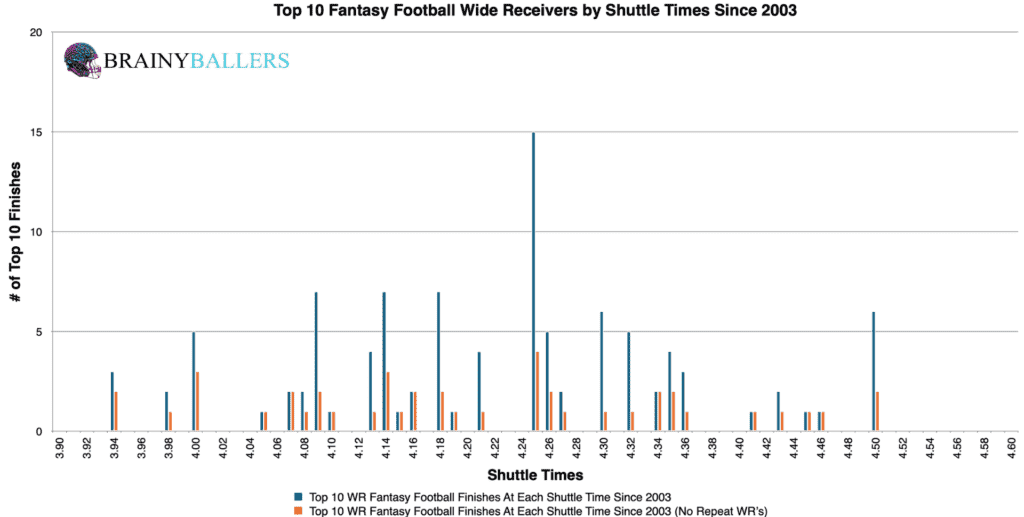
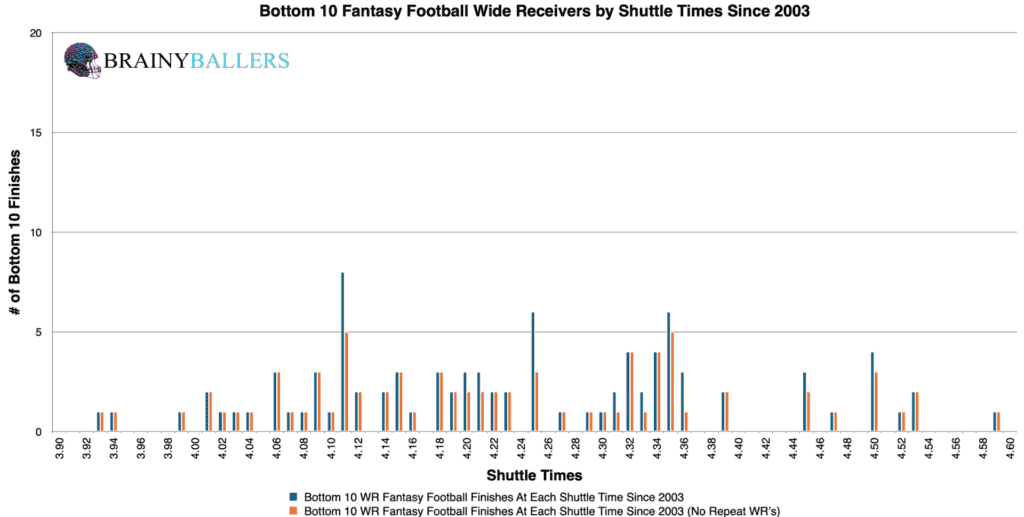
To achieve our goal of finding a range of shuttle times where more top-level performances occur versus bottom-level performances, we created a differences chart. This chart compares top 10 and bottom 10 NFL Combine shuttle times, plus the next 0.10 seconds, subtracting the bottom 10 results from the top 10. The chart’s desired outcome is a negative number for unique differences (Orange) and a positive number for non-unique differences (Blue). This would indicate the desired consistent top level performances we are hoping for. From this analysis, you can see that shuttle times of 4.35 seconds and under appears to be a potential performance range that correlates to higher NFL success. This was a big insight into setting the performance threshold, which we will verify next.
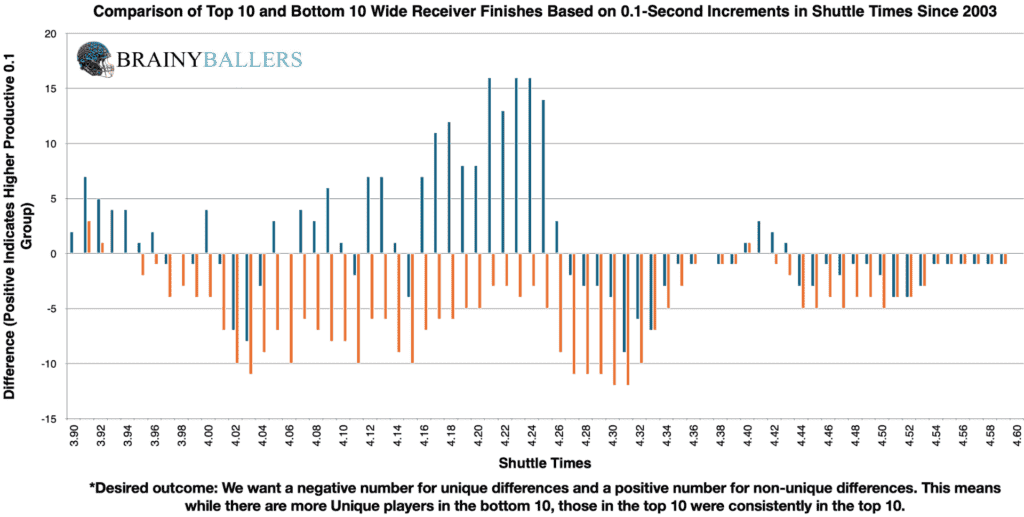
Next, we wanted to verify whether this range occured more amongst all WR’s, or if this occurred more just amongst top performing WR’s. Therefore, we ran the numbers to see how often this threshold occurred in the bottom 10. After this, we will compare against the top 10.
So here it is: for the bottom 10, there were 96 WRs in our data with shuttle times. 79 of which finished at or under 4.35 seconds. This accounted for 82.3%. This establishes a benchmark for comparing it to the top performers. If more than 82.3% occurred in the top 10, then we found a more frequent top performing Shuttle time threshold, which you will see next.
To determine whether our threshold represented the average WR’s shuttle time, or the average top-performing WR’s shuttle time, we applied it to all top 10 finishers from 2003 to 2023. Out of 103 top 10 finishers, 89 were in the 4.35 seconds and under range, accounting for 86.4%. This shows a 4.1% increase, which is relatively insignificant compared to our other findings and the most insignificant WR findings thus far. Luckily, we recently upgraded our spreadsheets to make quick threshold/range adjustments.
This fine-tuning ability helps us ensure we’ve identified the highest-producing range. After testing various numbers close to our initial findings, we found that adjusting the range to 3.87 to 4.30 seconds resulted in a 15.4% higher occurrence in the top 10 than in the bottom 10! This range will be the subject of this article going forward.
Due to these findings, shuttle times could play a small factor in our Star-Predictor Score (SPS) model. Since 4.50 is the slowest shuttle time seen since 2003 in the top 10, that will be our critical value for the SPS. The Star-Predictor Score (SPS) is a scouting tool designed to maximize investment potential and reduce risks when drafting rookies in Fantasy Football. It is proven to have a higher accuracy than draft capital alone to predict fantasy success. The SPS includes 13 to 17 metrics, with the exact number varying by the player’s position. All these metrics are pre-NFL, and some are invented by us, providing a complete analysis of a player’s analytical profiles. The SPS gained widespread notoriety for its high accuracy, having made it on Barstool and The Pat McAfee Show. The SPS can be found here.

We next wanted to use standard statistical methods to see if there is a correlation between shuttle times and fantasy production. Here are the findings:
For Pearson Values, we are hoping for a minimum of 0.1, or an inverse correlation maximum of -0.1 when we study world-class athletes as we are. For reference to something that everyone acknowledges matters in prospect scouting, and to show the accompanying Pearson value, RB draft capital prevailed a -0.234 Pearson value. This shows that shuttle times lack standard statistical support when looking at the Pearson value.
Despite the lack of regression testing support, we wanted to see if this is an emerging trend, or the opposite. By applying the optimal range to the last two decades, a trend emerged where most of the top 10 finishers consistently fell within 3.87 to 4.30 seconds more frequently in recent years. As you can see by comparing the frequency which this range shows up in the top 10 versus the bottom 10, there is a 15.6% increase in the last decade versus the 2004-2013 decade. This breakdown can be seen below:
| 2004-2013 | |||
| Top 10 | 11 through 40 | Bottom 10 | |
| All count | 35 | 162 | 38 |
| Between 3.87 and 4.30 | 27 | 116 | 27 |
| % (hard zone/all) | 77.1% | 71.6% | 71.1% |
| 2014-2023 | |||
| Top 10 | 11 through 40 | Bottom 10 | |
| All count | 62 | 174 | 55 |
| Between 3.87 and 4.30 | 45 | 100 | 28 |
| % (hard zone/all) | 72.6% | 57.5% | 50.9% |
To have some more fun, we found that the average shuttle time for all athletes was 4.22 seconds. Also, the median time was 4.21 seconds. If you want to get more specific, we found a much more narrow range which produces more top talent between 4.13 to 4.30. This range occurred in the top 10 at a 21.2% higher rate than the bottom 10.
What 3 metrics matter the most when scouting a rookie Quarterback? What threshold should Quarterbacks achieve within those metrics to be considered an elite prospect? How much should you value those stats above all other stats? Couldn't answer those questions? Rest easy, we have it handled for you. That's what this chart answers. Sort by importance and/or filter by position. Unlock by signing up with the links provided. $9.99/Year or $24.99 Lifetime access. Cancel anytime.
We attempted to uncover a specific shuttle time where the highest increase in performance occurs while also identifying the range where the least unique players appear, indicating top-level consistency. Through this research, we found that shuttle times between 3.87 and 4.30 seconds are not just an average WR measure, but an optimal performance threshold for top athletes. Although, it should be taken with a grain of salt as we seen no regression testing support for shuttle times alone being a performance predictor.
Our series has always sought to push the boundaries of sports analytics. This latest installment reaffirms our commitment to uncovering the hidden dynamics that define the game. Every Saturday, we’ll dive into intriguing questions, bust myths, and settle debates with thorough analysis. We welcome your input. Therefore, please leave comments or reach out with topics you’re eager to see dissected. Premium Analytics subscribers get priority. All of our research can be found on our Analytics Page. Up next on our agenda for Part 18 of “Does It Matter?” is an examination of the WR 3-Cone Drills: Do they matter? If so, what’s the 3-Cone time threshold necessary for success? Mark your calendars; every Saturday we shed light on the topics that matter to you. If you’re a Premium Analytics subscriber, all it takes is a quick question being asked and we will go to work for you!



In our 63-part analytical series, “Does It Matter?”, we next wanted to look into the intriguing question of whether a Tight End’s
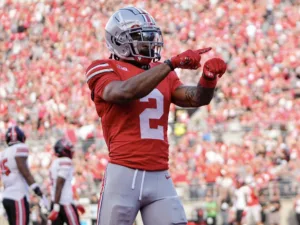
For our 61 part “Does It Matter?” series, we looked into whether a Wide Receiver’s College Yards After Catch per Reception (YAC/Rec)

In part 60 of our “Does It Matter?” series, we dove into the question of whether a college Wide Receiver’s career Average
© 2023 BrainyBallers | All Rights Reserved